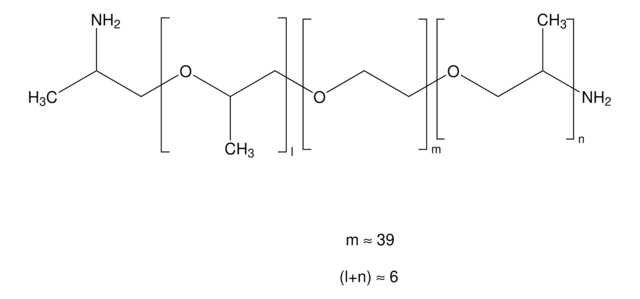435503
Poly(propylene glycol)-block-poly(ethylene glycol)-block-poly(propylene glycol)
average Mn ~3,300
Sinonimo/i:
Pluronic® 31R1
About This Item
Prodotti consigliati
Stato
viscous liquid
Livello qualitativo
PM
average Mn ~3,300
Composizione
PEG, 10 wt. %
Indice di rifrazione
n20/D 1.454
Tensione superficiale
34 dyn/cm, 25 °C, 0.1 wt. % in H2O
Viscosità
660 cP(25 °C, Brookfield)(lit.)
Temp. transizione
softening point −25 °C
cloud point 25 °C (1 wt. % aqueous solution)
Densità
1.018 g/mL at 25 °C
HLB
2.0 - 7.0
Stringa SMILE
O2C(C2)C.O1CC1
InChI
1S/C3H6O.C2H4O/c1-3-2-4-3;1-2-3-1/h3H,2H2,1H3;1-2H2
RVGRUAULSDPKGF-UHFFFAOYSA-N
Categorie correlate
Descrizione generale
Applicazioni
Caratteristiche e vantaggi
Note legali
Codice della classe di stoccaggio
10 - Combustible liquids
Classe di pericolosità dell'acqua (WGK)
WGK 3
Punto d’infiammabilità (°F)
Not applicable
Punto d’infiammabilità (°C)
Not applicable
Scegli una delle versioni più recenti:
Possiedi già questo prodotto?
I documenti relativi ai prodotti acquistati recentemente sono disponibili nell’Archivio dei documenti.
I clienti hanno visto anche
Articoli
Mesoporous materials are formed by a self-assembly process from combined solutions of sol-gel precursors (e.g., metal alkoxides) and structure-directing amphiphiles, usually block-copolymers or surfactants.
Il team dei nostri ricercatori vanta grande esperienza in tutte le aree della ricerca quali Life Science, scienza dei materiali, sintesi chimica, cromatografia, discipline analitiche, ecc..
Contatta l'Assistenza Tecnica.







